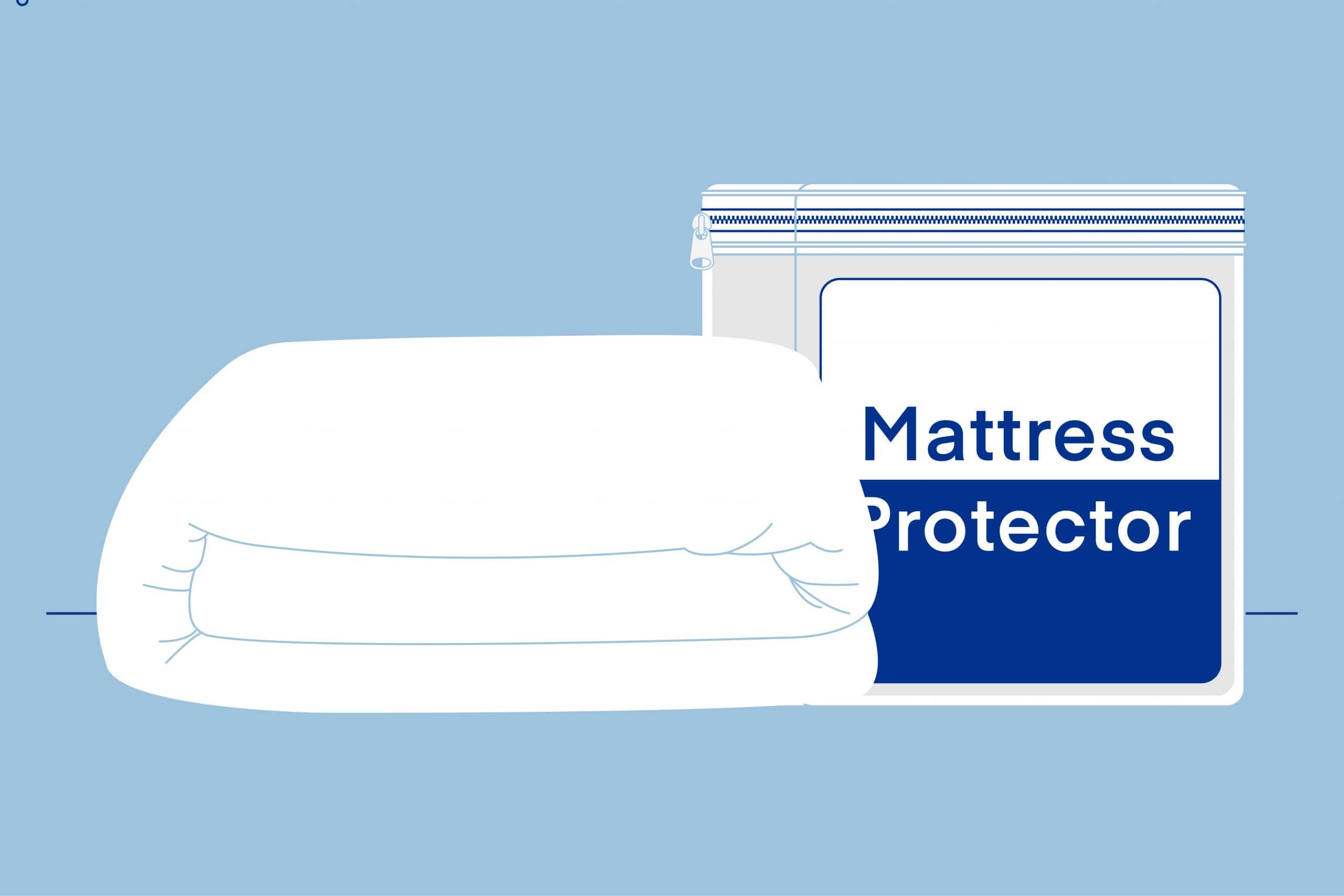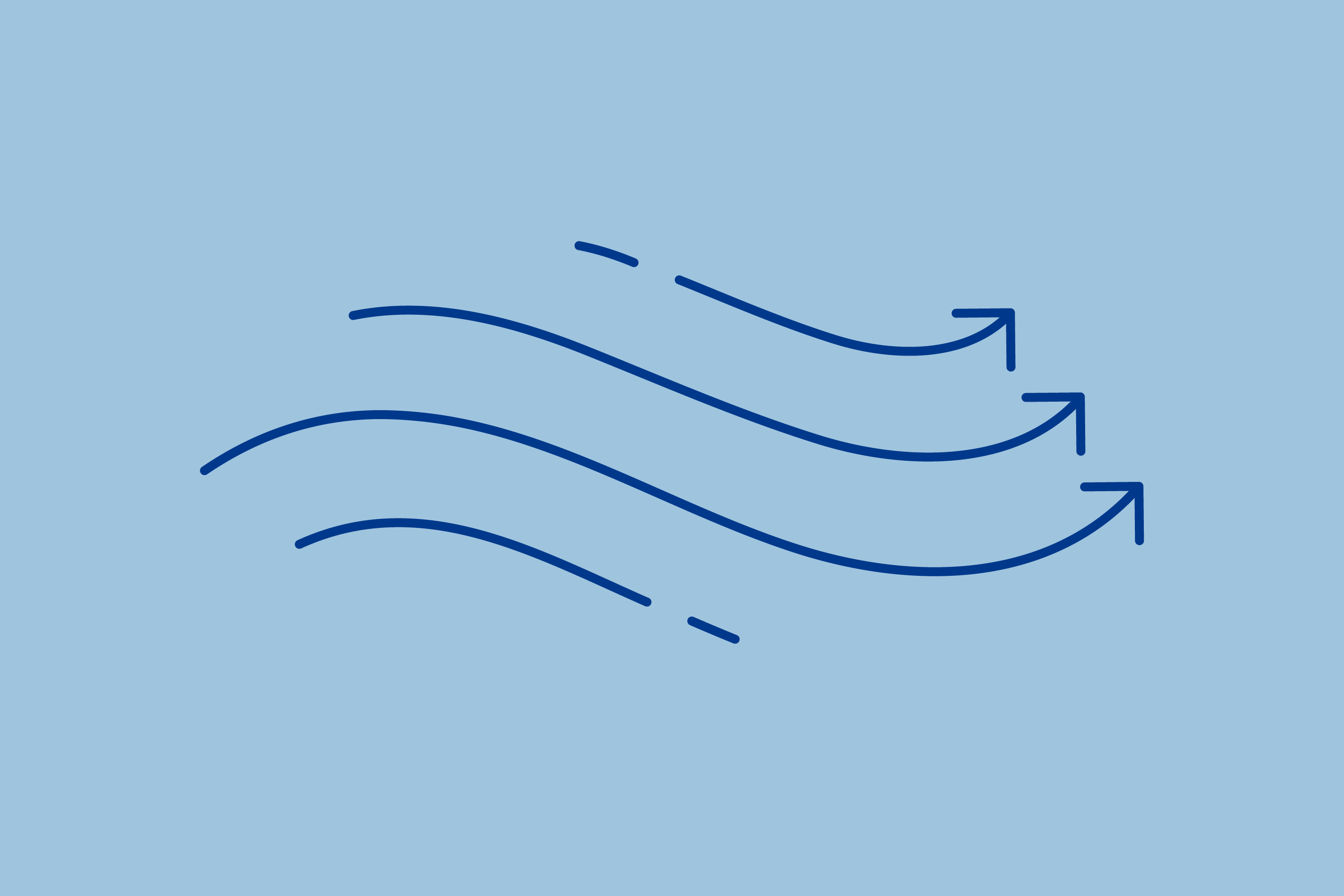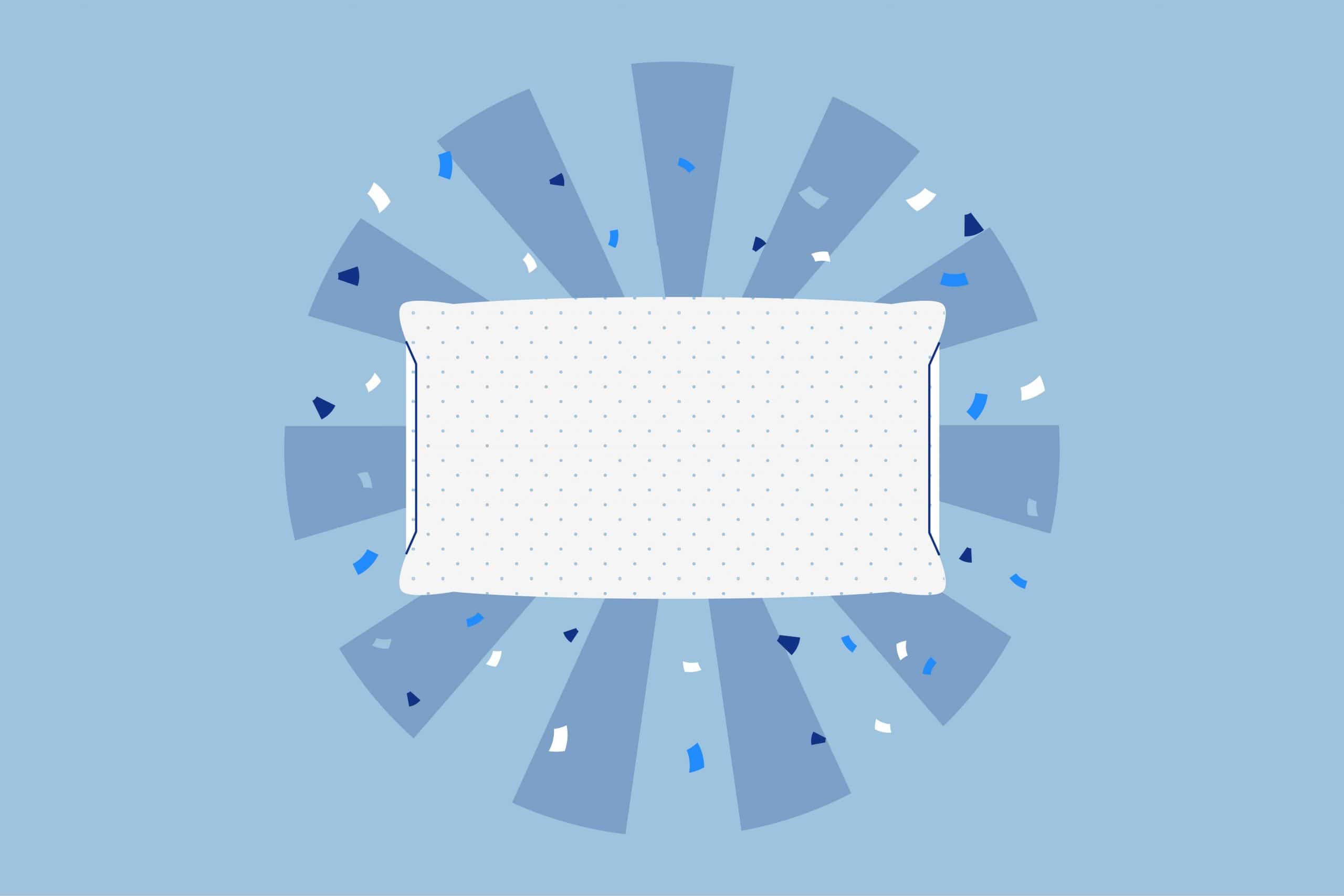Key Takeaways
- Why Choose a Mattress Protector: Mattress protectors are essential for safeguarding your mattress against spills, dust mites, moisture, and other contaminants, ultimately extending the lifespan of your mattress.
- Pick a Matching Size Protector: Choose a mattress protector that matches the size of your mattress, ensuring it fully encases your mattress. The wrong-sized protector can lead to premature wear and inadequate protection.
- Don’t Forget Pocket Depth Size to Accommodate Thickness: Pay attention to the pocket depth of the mattress protector, ensuring it is at least 1 inch thicker than your mattress to accommodate thicker beds or mattress toppers effectively.
Mattress protectors may look like a funny fitted sheet, but they’re much more than that. A mattress protector fits over your mattress the same way a fitted sheet does but is also a durable barrier with a waterproof backing.
They guard your mattress against spills, dust mites, moisture, and other bacteria. Using a mattress protector helps your mattress last longer.
Mattress protectors have roughly the same dimensions as standard mattress sizes. However, it’s important to measure your mattress and ensure you get a protector thick enough to fully encase it. Too small of a protector will wear down your mattress and won’t properly protect it.
We break down the sizes and dimensions of every mattress protector, which mattress they work for, and who should use that type of mattress.
Quick Guide: A 30-Second Summary
| Best Mattress Protector | Amerisleep Mattress Protector |
Mattress Protector Sizes and Dimensions
| Mattress Protector Size | Dimensions (inches) | Dimensions (cm) |
|---|---|---|
| Twin | 38 x 74 | 96.5 x 190.5 |
| Twin XL | 38 x 80 | 96.5 x 203.2 |
| Full (Double) | 54 x 75 | 137.1 x 190.5 |
| Queen | 60 x 80 | 152.4 x 203.2 |
| King | 76 x 80 | 193 x 203.2 |
| California King | 72 x 84 | 182.9 x 213.4 |
Twin
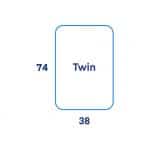 Dimensions: 38 x 74 inches
Dimensions: 38 x 74 inches
Twin mattress protectors are suited for twin mattresses. Twin mattresses are excellent for toddlers transitioning out of their cribs, children, teens, and single adult sleepers. Since twin beds are so small, they fit in most bedrooms. Another great part of twin beds is they work with unique, space-saving bed frames such as bunk beds, daybeds, trundle beds, and more.
Twin XL
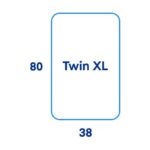 Dimensions: 38 x 80 inches
Dimensions: 38 x 80 inches
Twin XL protectors pair well with twin XL mattresses. As the name suggests, twin XL beds are a larger version of twin beds.
Twin XL mattresses are 5 inches longer than twin mattresses, making them an excellent choice for single adults, college students, and teens who are taller than 6 feet (183 centimeters). They’re also a good bed for guests as they fit a wider range of people. Our twin vs twin XL mattress guide discusses the two sizes in depth.
Full (Double)
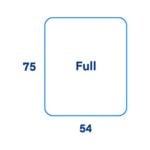 Dimensions: 54 x 75 inches
Dimensions: 54 x 75 inches
Full mattresses work best for full, or double, mattress protectors. Although full beds are wider than twin beds, they’re not large enough for two people. Instead, full mattresses work best for sleepers who need more space to themselves and like spreading out.
Still, full beds are small enough to fit in most bedrooms and are great in guest bedrooms and in older children’s bedrooms.
Like twin beds, you can find full XL (double XL) mattresses, though they’re quite rare. If you do go with a full XL mattress, choose a full XL mattress protector, which measures 54 inches wide by 80 inches long.
Queen
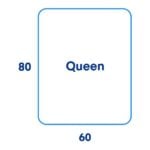 Dimensions: 60 x 80 inches
Dimensions: 60 x 80 inches
Queen protectors go over queen mattresses, which fit in most master bedrooms and larger average bedrooms. As a large bed, it also works as a good mattress for guest rooms if you have multiple people visiting.
Queen is the most popular mattress size amongst single adults and couples. Queen beds are the smallest mattress size we recommend for couples. They give enough space for both people to sleep comfortably without bumping into each other.
King
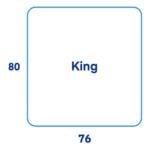 Dimensions: 76 x 80 inches
Dimensions: 76 x 80 inches
King size mattress protectors are fit for king mattresses, the largest standard mattress size on the market. They’re a good idea for couples looking for extra room for themselves and people with large master bedrooms.
Another type of king mattress is the split king, a mattress split in half. Otherwise, a split king has the same dimensions as a standard king.
Split king mattresses are popular amongst couples with different mattress preferences, whether it be firmness or type. Even couples who agree on firmness may choose a split king mattress if they plan on sharing an adjustable bed. While a standard king mattress moves as a whole, a split king lets each partner customize their side.
A split king is equal to two twin XL beds. With a split king mattress, you have the choice between getting two twin XL protectors or one king size protector. Two twin XL mattress protectors are ideal if you use a split adjustable base. Otherwise, one king mattress protector should work fine.
California King
 Dimensions: 72 x 84 inches
Dimensions: 72 x 84 inches
California king mattress protectors pair with California king beds. Although California king beds may seem like the largest mattress size, they’re not. They’re the longest standard mattress size but are ultimately smaller than king mattresses since they’re more narrow.
Cal king mattresses are best for exceptionally tall individuals and couples. While Cal kings are more narrow than king beds, they’re still wide enough for two people to sleep comfortably.
Like standard king mattresses, you can find split California king beds. If you want separate protectors for both sides of the mattress, you’ll have to find specialized split Cal king mattress protectors. This is because the two halves of a California king bed don’t match a smaller standard mattress size.
Mattress Protector Pocket Depth
 Your mattress protector’s pocket depth refers to how large your mattress protector is—thickness-wise—and far it can stretch. This is important if you have a thicker-than-average mattress or use a mattress topper since most beds are only between 9 to 12 inches.
Your mattress protector’s pocket depth refers to how large your mattress protector is—thickness-wise—and far it can stretch. This is important if you have a thicker-than-average mattress or use a mattress topper since most beds are only between 9 to 12 inches.
When it comes to your mattress protector, you don’t want it to be overly tight by stretching over too thick of a bed. Not only is it hard to get a small protector onto a thick bed, but it causes the protector to pop off at night and potentially tear.
Also, an overly snug protector places stress on the topper, leading it to wear down quickly. Slightly larger protectors can also move better on a zero-gravity bed.
Ideally, your mattress protector should be at least 1 inch thicker than your actual mattress. So, if your protector is 14 inches thick, it’ll fit mattresses that are 12 or 13 inches thick.
If you aren’t sure how thick your mattress is, place yardsticks or small pieces of wood on either side of the mattress. Next, measure the distance between the two yardsticks or wood to measure your bed’s thickness.
About the Amerisleep Waterproof Mattress Protector
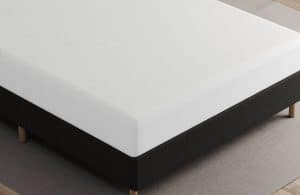 For a cooling mattress protector resistant to spills, bugs, and other accidents, take a look at our Amerisleep Waterproof Mattress Protector. While the protector is thin to promote air circulation, it’s still durable and ensures your bed is safe.
For a cooling mattress protector resistant to spills, bugs, and other accidents, take a look at our Amerisleep Waterproof Mattress Protector. While the protector is thin to promote air circulation, it’s still durable and ensures your bed is safe.
Our protector is made from a soft cotton-blend jersey and has stretchy poly skirting. Under the jersey knit is a non-toxic laminated fill designed to ward off bacteria and liquids. It’s an especially useful protector for allergies because it keeps your bed safe from allergens including dead skin cells, dust mites, and bed bugs.
The Waterproof Mattress Protector comes in sizes twin through California king. There’s even a split king option suited for dual mattresses and adjustable beds. Since the protector’s pocket is so stretchy, it fits mattresses between 8 to 18 inches thick.
The Waterproof Mattress Protector is Standard 100 by OEKO-TEX® certified and comes with a 5-year warranty.
More Mattress and Bedding Size Guides
Mattress protectors aren’t the only item that comes in specialty sizes, and it’s important to choose the correct size as you shop for mattresses and their accessories.
- RV Mattress Sizes and Types
- Mattress Sizes and Dimensions in Canada
- Bunk Bed Mattress Size Guide
- Hospital Bed Mattress Sizes and Dimensions
- Bed Sheet Sizes and Dimensions Guide
- Bed Frame Sizes and Dimensions Guide
- Adjustable Bed Sizes and Dimensions Guide
- Blanket Sizes and Dimensions Guide
- Murphy Bed Sizes and Dimensions Guide
- Bed Pillow Sizes Guide
- Headboard Sizes Chart and Dimensions Guide
- Pillowcase Sizes and Dimensions
- Mattress Foundation Sizes and Dimensions Guide
- Duvet Sizes and Dimensions Guide
- Comforter Sizes and Bedding Chart
How a Mattress Protector Minimizes Cleaning
One primary benefit of using a mattress protector is its ability to create a barrier between your mattress and external elements, preventing moisture, dust mites, and allergens from infiltrating the mattress material. This is particularly beneficial for individuals who suffer from allergies or asthma, as a protector helps maintain a cleaner and healthier sleep environment.
A mattress protector is also a smart item to own as a crucial defense against accidents and spills, when it will save you from having to consult one of our many guides to mattress cleaning:
- How to Remove Urine Stains and Smell From a Mattress
- How to Remove Blood Stains on Your Mattress
- How to Clean Vomit from a Mattress
- How to Get Poop Stains out of a Mattress
- How to Remove Coffee Stains from Your Mattress
- How to Remove Makeup Stains from Mattresses
- How to Remove Ink Stains from a Mattress
- How to Get Sweat Stains Out of a Mattress
- How to Clean Water Stains From a Mattress
- How to Remove Rust Stains on a Mattress
- How to Dry a Wet Mattress After Water Damage
A mattress protector can also save your mattress from a pest infestation:
- Signs You Have Fleas in Your Bed
- How to Get Rid of Ants in Your Bed
- How To Treat Your Mattress For Lice
- How to Get Rid of Scabies From Mattress
- Should I Be Concerned About a Silverfish in Bed?
- How to Keep Centipedes Out of Your Bed
- Should I Be Concerned About a Tick in Bed?
- How to Keep Spiders out of the Bedroom
- How to Keep Mice Out of Your Bed
- How to Keep Cockroaches out of the Bedroom
- How to Spot Mold on Mattress
Another critical aspect to consider when contemplating a mattress protector is the presence of fiberglass in mattresses. Fiberglass is a fire-retardant material commonly used in mattresses to enhance safety. However, it can pose a challenge when the mattress is exposed or damaged.
In the event of a tear or breakage, fiberglass particles may be released into the air, posing potential respiratory risks and skin irritation. It’s difficult to clean up loose mattress fiberglass, too. Sometimes, it requires professional cleaning.
A high-quality mattress protector acts as an additional barrier, preventing the escape of fiberglass particles and minimizing the associated health concerns. However, it’s best to replace it with a fiberglass-free mattress when you can.
Other Cleaning Guides
For pillows:
- How to Wash and Dry All of Your Pillows
- How to Disinfect Your Pillow
- How to Fluff a Pillow
- How to Wash a Body Pillow
For sheets:
- How Often Should You Wash Your Sheets?
- How to Make Sheets White with Household Items
- Can You Wash Sheets with Clothes and Other Items?
For other bedding items:
- How To Clean a Memory Foam Mattress Topper
- How to Clean a Comforter
- How Long Does It Take to Dry Clean a Comforter?
- How to Wash a Quilt
FAQs
Do you need a mattress protector?
While you can technically use a mattress without a protector, we always recommend using a mattress protector over your bed. This reduces the risk of stains, water damage, and overall mattress wear, so you can help your mattress last longer.
Beyond that, many mattress manufacturers require you to use a mattress protector at all times to keep your warranty intact. If your warranty is void, you’ll be responsible for repairing defects and other mattress wear.
Do mattress protectors make the bed less comfortable?
No, a mattress protector is a waterproof barrier that goes over your bed to ward off germs and leaks but isn’t shouldn’t have any major impact on your bed’s feel. Some mattress protectors reduce your bed’s breathability, but this isn’t common. If you’re looking for a mattress protector to make your bed more comfortable, look for padded protectors filled with materials such as polyester, cotton, polyurethane foam (poly-foam), or down.
You could also pair the mattress protector with a mattress pad or mattress topper. A mattress topper acts as an extra comfort layer for your bed. If you go down this route, be sure to get a mattress protector deep enough for both your mattress and the topper.
How often should you wash a mattress protector?
We recommend washing your mattress protector once or twice a month. If you tend to sweat a lot at night or have allergies, two or three washes per month is ideal, otherwise one or two is enough. Of course, if you have any spills or accidents, remove the protector from your mattress and wash it as soon as possible.
Most mattress protectors are machine-washable and safe to tumble dry but always double-check the manufacturer guidelines so they don’t break down rapidly.
How often should you replace a mattress protector?
Replace your mattress protector once every 1 to 2 years to ensure your mattress is well-protected. Even with regular washes, your mattress protector will trap bacteria such as dust, bed bugs, and moisture over time, leaving your mattress vulnerable. The same goes for most of your other bedding, including your pillows, sheets, and duvet covers.
What’s the difference between a mattress protector and a mattress pad?
Mattress protectors and mattress pads have different functions. Mattress protectors are waterproof barriers that keep your mattress safe from bacteria such as allergens, mold, urine, and other fluids. These can also stink up your bed, and mold on a mattress can especially be bad for your health.
Mattress pads add an extra layer of cushioning to your mattress and are a good way to improve the feel of an older bed. While both pads and protectors help your mattress last longer, mattress pads aren’t stain-resistant or water-resistant. You’ll need a mattress protector over your mattress pad.
If you’re looking to protect your mattress against stains and dirt but also want extra cushioning, consider using a mattress topper and a mattress protector.
Conclusion
Using a mattress protector ensures your mattress is safe from harmful bacteria and keeps your warranty intact. While a mattress protector does nothing for your comfort at night, it ensures you can use your bed for as long as possible! Choose a mattress protector size equal to your mattress size and ensure its pocket depth is larger than your bed’s thickness.
Just make sure to measure your mattress and double-check its dimensions. After all, you don’t want to end up with a protector too small to slip over a mattress.
About the author
Geoff McKinnen is a writer focusing mainly on the healthcare industry and has written articles on everything from foods to help you lose weight to the connection between Alzheimer’s and sleep. Geoff’s passionate about helping readers improve their well-being to lead happier lives. Outside of work, Geoff enjoys cycling and hiking and believes that by leading a healthy lifestyle, he can help others do the same.
View all posts